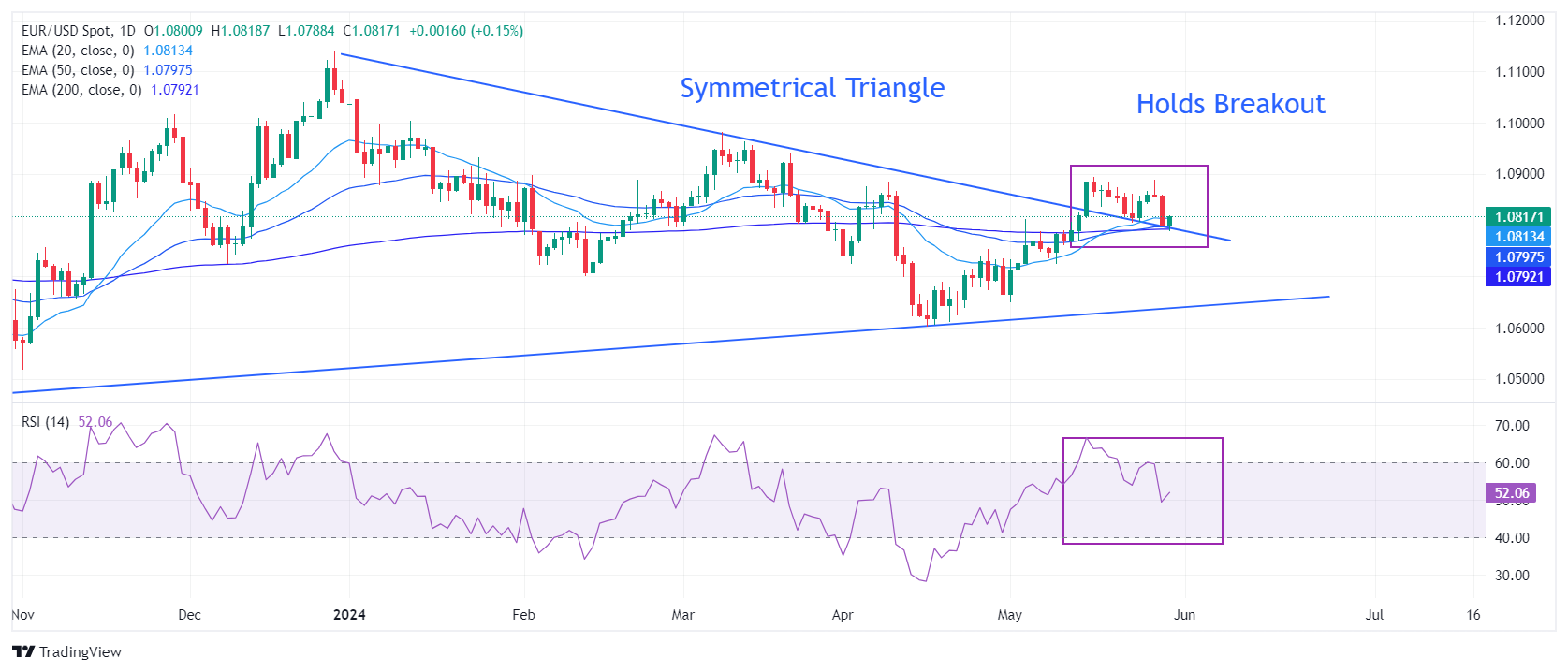- EUR/USD rebounds after falling below 1.0800 as US Dollar corrects sharply.
- The ECB is expected to cut rates at its June policy meeting.
- The US core PCE price index is estimated to have grown steadily in April.
EUR/USD recovers after falling below the crucial support of 1.0800 in the American session on Thursday. EUR/USD recovers as the US Dollar (USD) extends its correction after the revised first quarter real Gross Domestic Product (GDP) report showed the United States (US) grew at a slower rate than 1.3% from advanced estimates of 1.6%. The US Dollar Index (DXY), which tracks the value of the Dollar against six major currencies, falls to 104.70 after posting a new two-week high slightly above 105.00.
Previously, investors were enthusiastic about the US dollar as they expected the Federal Reserve (Fed) not to lean towards interest rate cuts anytime soon. Fed policymakers have made clear that they want to see inflation slow for months to gain confidence that price pressures will sustainably return to the desired 2% rate.
Fed officials see further rate hikes as less likely, but have kept the possibility on the table if progress on the disinflation process stalls. For fresh clues on the outlook for interest rates, investors are turning their attention to U.S. Core Personal Consumption Expenditure (PCE) price index data for April, due out on Friday and which will significantly influence speculation about Fed rate cuts in September. The annual and monthly readings of core PCE inflation are estimated to have grown steadily by 2.8% and 0.3%, respectively.
Market Drivers: EUR/USD Recovers Further as US Dollar Correction Deepens
- EUR/USD rebounds sharply from the 1.0800 round level support. EUR/USD recovers intraday losses even though investors are confident that the European Central Bank (ECB) seems ready to start reducing interest rates from the June meeting, while the Fed has not budged. committed to the timing of rate cuts.
- Noting that Eurozone core inflation has already declined to 2.7% and that progress on the services disinflation process has resumed after stalling in the November-March period, ECB policymakers are comfortable with the expectations that the central bank will pivot towards policy normalization starting in June.
- With the June rate cut looking like a given, speculation on the ECB's rate cut path beyond June will project the next move in the Euro. Financial markets currently expect the ECB to make one more cut this year. However, a Reuters poll of 82 economists from May 21 to 28 has suggested that the ECB will make two more rate cuts this year.
- At the start of the year, investors predicted that the ECB would cut interest rates six times this year. However, expectations about the number of rate cuts were lowered as ECB policymakers warned that an aggressive approach to policy easing could reignite price pressures again. Additionally, uncertainty over wage growth momentum has led to the likelihood of following a gradual approach to rate cuts.
- On the economic front, investors will focus on preliminary Eurozone inflation data for May, due to be released on Friday. Inflation data will provide clues on how far and how quickly the ECB will cut key interest rates. Economists expect the annual Harmonized Index of Consumer Prices (HICP) to have risen at a stronger pace of 2.5% from the previous reading of 2.4%. The annual underlying HICP is estimated to have accelerated to 2.8% from 2.7% in April.
- Meanwhile, the Eurozone unemployment rate for May falls to 6.4% from estimates and the previous reading of 6.5%.
Technical Analysis: EUR/USD recovers after testing triangle breakout region near 1.0800
EUR/USD recovers after finding buying interest near the breakout of the symmetrical triangle chart pattern formed on a daily time frame, which is slightly below 1.0800. The short-term outlook for the pair is uncertain as it struggles to stay above all short- to long-term exponential moving averages (EMAs).
The 14-period RSI has fallen into the 40.00-60.00 range, suggesting that the momentum, which was leaning towards the upside, has faded for now.
EUR/USD would strengthen if it reclaims a two-month high around 1.0900. A decisive break above this level would take the pair towards the March 21 high, around 1.0950, and the psychological resistance of 1.1000. However, a downside move below the 200-day EMA at 1.0800 could push it further lower.
Economic Indicator
Annualized Gross Domestic Product
The Annualized Real Gross Domestic Product (GDP), published quarterly by the US Bureau of Economic Analysis, measures the value of final goods and services produced in the United States in a given time period. Changes in GDP are the most popular indicator of the nation's overall economic health. The data is expressed at an annualized rate, which means that the rate has been adjusted to reflect the amount that GDP would have changed in one year, if it had continued to grow at that specific rate. Generally speaking, a high reading is considered bullish for the US Dollar (USD), while a low reading is considered bearish.
Why is it important for traders?
The US Bureau of Economic Analysis (BEA) publishes Gross Domestic Product (GDP) growth on an annualized basis for each quarter. After publishing the first estimate, the BEA reviews the data two more times, with the third publication being the final reading. Typically, the first estimate is the main market driver and a positive surprise is considered a positive development for the USD, while a disappointing number will likely weigh on the dollar. Market participants generally dismiss the second and third releases as they are generally not significant enough to significantly alter the growth picture.
Source: Fx Street
I am Joshua Winder, a senior-level journalist and editor at World Stock Market. I specialize in covering news related to the stock market and economic trends. With more than 8 years of experience in this field, I have become an expert in financial reporting.








